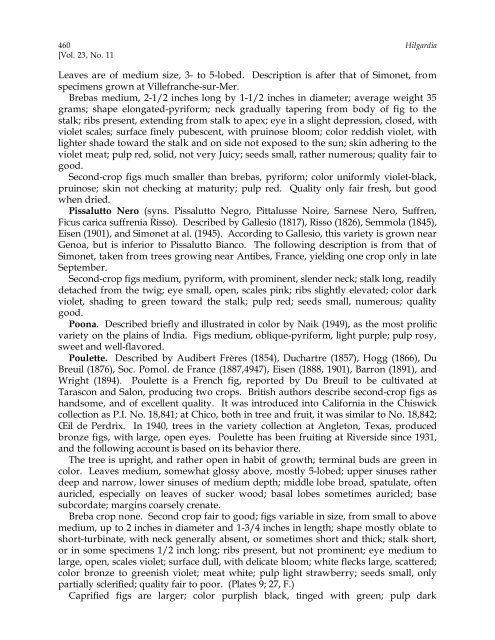Fig Varieties: A Monograph - uri=ucce.ucdavis
Fig Varieties: A Monograph - uri=ucce.ucdavis
Fig Varieties: A Monograph - uri=ucce.ucdavis
You also want an ePaper? Increase the reach of your titles
YUMPU automatically turns print PDFs into web optimized ePapers that Google loves.
460 Hilgardia<br />
[Vol. 23, No. 11<br />
Leaves are of medium size, 3- to 5-lobed. Description is after that of Simonet, from<br />
specimens grown at Villefranche-sur-Mer.<br />
Brebas medium, 2-1/2 inches long by 1-1/2 inches in diameter; average weight 35<br />
grams; shape elongated-pyriform; neck gradually tapering from body of fig to the<br />
stalk; ribs present, extending from stalk to apex; eye in a slight depression, closed, with<br />
violet scales; surface finely pubescent, with pruinose bloom; color reddish violet, with<br />
lighter shade toward the stalk and on side not exposed to the sun; skin adhering to the<br />
violet meat; pulp red, solid, not very Juicy; seeds small, rather numerous; quality fair to<br />
good.<br />
Second-crop figs much smaller than brebas, pyriform; color uniformly violet-black,<br />
pruinose; skin not checking at maturity; pulp red. Quality only fair fresh, but good<br />
when dried.<br />
Pissalutto Nero (syns. Pissalutto Negro, Pittalusse Noire, Sarnese Nero, Suffren,<br />
Ficus carica suffrenia Risso). Described by Gallesio (1817), Risso (1826), Semmola (1845),<br />
Eisen (1901), and Simonet at al. (1945). According to Gallesio, this variety is grown near<br />
Genoa, but is inferior to Pissalutto Bianco. The following description is from that of<br />
Simonet, taken from trees growing near Antibes, France, yielding one crop only in late<br />
September.<br />
Second-crop figs medium, pyriform, with prominent, slender neck; stalk long, readily<br />
detached from the twig; eye small, open, scales pink; ribs slightly elevated; color dark<br />
violet, shading to green toward the stalk; pulp red; seeds small, numerous; quality<br />
good.<br />
Poona. Described briefly and illustrated in color by Naik (1949), as the most prolific<br />
variety on the plains of India. <strong>Fig</strong>s medium, oblique-pyriform, light purple; pulp rosy,<br />
sweet and well-flavored.<br />
Poulette. Described by Audibert Frères (1854), Duchartre (1857), Hogg (1866), Du<br />
Breuil (1876), Soc. Pomol. de France (1887,4947), Eisen (1888, 1901), Barron (1891), and<br />
Wright (1894). Poulette is a French fig, reported by Du Breuil to be cultivated at<br />
Tarascon and Salon, producing two crops. British authors describe second-crop figs as<br />
handsome, and of excellent quality. It was introduced into California in the Chiswick<br />
collection as P.I. No. 18,841; at Chico, both in tree and fruit, it was similar to No. 18,842;<br />
Œil de Perdrix. In 1940, trees in the variety collection at Angleton, Texas, produced<br />
bronze figs, with large, open eyes. Poulette has been fruiting at Riverside since 1931,<br />
and the following account is based on its behavior there.<br />
The tree is upright, and rather open in habit of growth; terminal buds are green in<br />
color. Leaves medium, somewhat glossy above, mostly 5-lobed; upper sinuses rather<br />
deep and narrow, lower sinuses of medium depth; middle lobe broad, spatulate, often<br />
auricled, especially on leaves of sucker wood; basal lobes sometimes auricled; base<br />
subcordate; margins coarsely crenate.<br />
Breba crop none. Second crop fair to good; figs variable in size, from small to above<br />
medium, up to 2 inches in diameter and 1-3/4 inches in length; shape mostly oblate to<br />
short-turbinate, with neck generally absent, or sometimes short and thick; stalk short,<br />
or in some specimens 1/2 inch long; ribs present, but not prominent; eye medium to<br />
large, open, scales violet; surface dull, with delicate bloom; white flecks large, scattered;<br />
color bronze to greenish violet; meat white; pulp light strawberry; seeds small, only<br />
partially sclerified; quality fair to poor. (Plates 9; 27, F.)<br />
Caprified figs are larger; color purplish black, tinged with green; pulp dark
















![Fig Trees in North Carolina [Archive] - IDigMyGarden ... - Figs 4 Fun](https://img.yumpu.com/26905320/1/190x245/fig-trees-in-north-carolina-archive-idigmygarden-figs-4-fun.jpg?quality=85)